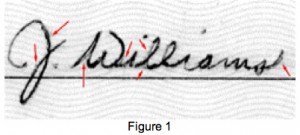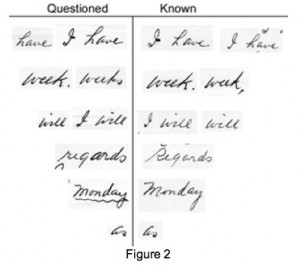 Most questioned document cases involve the examination or comparison of handwriting, signatures, numerals, initials or hand printing.
Most questioned document cases involve the examination or comparison of handwriting, signatures, numerals, initials or hand printing.
Handwritten entries may contain features that attest to their genuine or fraudulent nature. Consequently, it may be possible to determine the spurious nature of a document by conducting an independent assessment of the contested entry.
 Remnants of a pencil guideline are visible in the region surrounding the signature in Figure 1. Blunt endings, smudging, retouching and tremor provide strong evidence that this signature was traced from a genuine model.
Remnants of a pencil guideline are visible in the region surrounding the signature in Figure 1. Blunt endings, smudging, retouching and tremor provide strong evidence that this signature was traced from a genuine model.
It may be important to know if several anonymous letters were written by the same person or by different writers. In such cases, questioned writings on several documents are examined collectively to determine if they are all the product of one writer.
 More often, a contested writing is usually compared to specimen handwriting produced by one or more writers in an effort to identify the author and eliminate those not responsible for the questioned writing. Figure 2 shows several features common to both the questioned writing and specimens produced by a suspect.
More often, a contested writing is usually compared to specimen handwriting produced by one or more writers in an effort to identify the author and eliminate those not responsible for the questioned writing. Figure 2 shows several features common to both the questioned writing and specimens produced by a suspect.
The document examiner must have access to a suitable quantity of specimens in order to conduct a proper handwriting comparison. These specimens should contain letters and letter combinations similar to those that appear in the questioned document. Click here for information on how to collect specimens suitable for conducting a proper handwriting comparison.